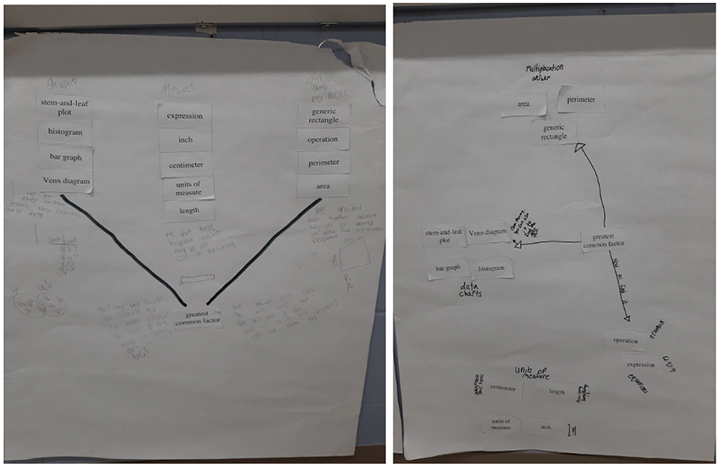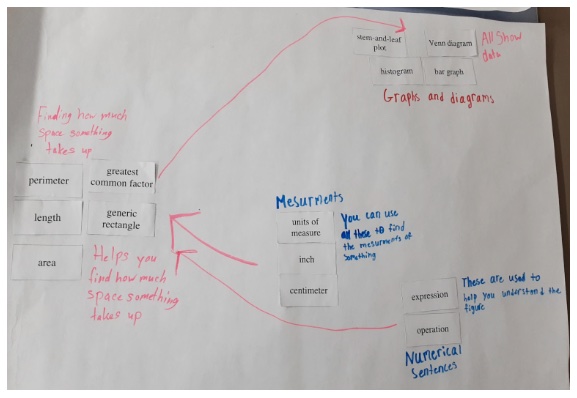Aleana Rodig, Brussels, WI arodig@sdsd.k12.wi.us
“What is the goal of your lesson?” This is one of the first, and most important, questions my coach, John Hayes asks as he sits down with me to plan a lesson. I was planning the Chapter 2 Closure activity and chose to have students complete concept maps. This would be the first concept map completed by my students this school year. I wanted my students to reflect, think deeply, and make connections amongst the topics they had learned.
I envisioned a Gallery Walk after the concept maps were completed. This would give students the ability to see their classmates’ work and reflect on similarities and differences of their own. After explaining this to John he asked, “How will you know if they are reflecting?” and “What will it look and sound like?” Initially, I was not sure how to respond, but as John and I worked through these questions, my lesson really started to come alive.
At the beginning of the year, my colleagues and I made posters of sentence starters for self and peer assessment. These sentence starters were on the front wall of my classroom all year but I had not used them intentionally with any lesson. John and I came up with a plan to create a Gallery Walk with an objective for students to look critically at their peers’ work while providing meaningful feedback.

Once the concept maps were complete, I would have the teams choose one student to stay with their concept map to explain it to other teams as they did the Gallery Walk. The rest of the students in the team would be randomly assigned either the “What was done well?”, “What could be improved?”, or “What are the next steps?” sentence starters. As students traveled to each of the other posters, they would listen to the mini-presentation and then provide feedback using the sentence starters. This would give each student an intentional lens while listening to the presentation. Each rotation was three minutes long, with a timer visibly counting down.
After students completed the Gallery Walk, they would go back to their own teams. The team presenter would be given a few minutes to relay the feedback back to the team members. The lesson would close with a Think-Ink-Pair-Share where students would be given two minutes to think and ink Two Stars and a Wish. This would give individual students the opportunity to reflect on the lesson and then share their thoughts with their team and the class.
My lesson goal was now very clear and concise and I could not wait to teach the lesson.
After discussing the goals of the lesson, students got to work completing their concept maps. As they worked, I supported teams by facilitating discussions and questioning their thinking. I was very impressed by how well they collaborated and discussed the various concepts learned in the chapter. Students grouped the concepts, wrote definitions, drew arrows to connect various topics, and drew pictures to provide a visual. When I noticed a few teams in one class struggling to come up with ideas I used the Study Team and Teaching Strategy, I Spy. This allowed one team member to go to a different team to get inspiration for their own posters. This worked well.


When it was time for the Gallery Walk I could tell students were focused on the presentations and listening intentionally. After each presentation, they would look at the sentence starters to start forming their feedback. I was very impressed with the specific, intentional feedback students were giving their classmates. This also allowed for additional discussions about posters that typically did not happen in Gallery Walks I have done in the past.
During the Think-Ink-Pair-Share Two Stars and a Wish closure, students shared that they liked having sentence starters to help them form their feedback. One student said they never know what to say but this helped them be more specific. Teams were not able to rotate through all of the posters in all of my classes so some of the “wishes” included having more time to see all of the posters. I had quite a few Facilitators express their wish to be able to see other posters instead of staying with their poster the whole time. One Facilitator also reflected that their first presentation did not go very well, but the more presentations they did, the better they got. They said the feedback from the first team also helped their presentation.
One of the reasons I love CPM is because of the various strategies they provide. This lesson is evidence that you can take any simple strategy and add complex elements to truly bring it alive and conquer a lesson goal more than you ever thought possible.

